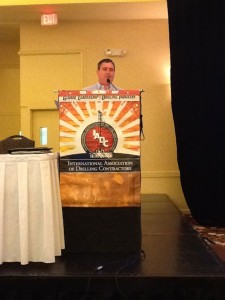API RP2D 7th edition proposed detailed training requirements
By Katherine Scott, editorial coordinator

The training section of API RP2D’s 7th edition will vastly dial up its focus on rigger training, according to Brandon Bollinger, Gulf Crane Services, president, and chairman of the API RP2D training committee, who spoke at the 2012 IADC Lifting and Mechanical Handling Conference & Exhibition on 19 July in Lafayette, La. “We spent a lot of time on rigger training because that’s where most of our accidents were happening,” Mr Bollinger said. Once the new edition of RP2D is finalized, he said, “you’re not going to be able to just have a shackle or a piece of wire rope to do rigger training. It’s going to be very detailed of what you should have.”
Mr Bollinger noted that proposed changes to the 7th edition include 30-plus pages of material on training requirements, a significant increase from the four pages within the 6th edition.
Course duration is another big change. An individual would need to take courses that are, at minimum, 16 hours to qualify as a rigger, Mr Bollinger continued. “Currently, courses can be four hours for a rigger. This is something that will point trainers in the right direction,” he said. Likewise, crane operators will be required to have a minimum of 24 hours course duration. Combined with the rigger training training that a crane operator must undergo, that means a total of 40 hours of training. Further, the 7th edition proposes that there be 10 or fewer students trained per trainer.
Crane inspector training also will be bulked up from the current one-page document, Mr Bollinger pointed out. Course exams would have a minimum of 100 questions with a minimum of 40 hours course duration, making it more stringent than rigger and crane operator training.
Another important distinction in the 7th edition is whether a qualified inspector is also a qualified crane operator. “We had to lean toward what was best for the industry. This is a worldwide standard; it had to fit everything,” Mr Bollinger said. It was decided that a qualified inspector did not need to first be a qualified crane operator. In order to assume a double role, a qualified crane inspector would need to complete the necessary crane operator requirements, he said
The 7th edition of RP2D will also include better definitions of jobs, including what defines a qualified rigger, a qualified crane inspector and, specifically, a qualified crane operator. “We figured out that we didn’t have a good, clear definition (in the 6th edition),” Mr Bollinger said. The proposed definition would state that a qualified crane operator is “a person who performs the act of or process of raising or lowering a load using a mechanical or non-mechanical crane.”
The changes in API RP2D’s training section will be more detailed to enable safer operations, Mr Bollinger said. “There’s a lot of information that really needs to be covered to ensure that your crane operator’s have the knowledge of the crane.”
Mr Bollinger noted that the 7th edition is almost finalized and that people could learn more about the training section draft at the general API RP2D meeting on 16 August at Anadarko’s office in the Woodlands. Registration is not required.




